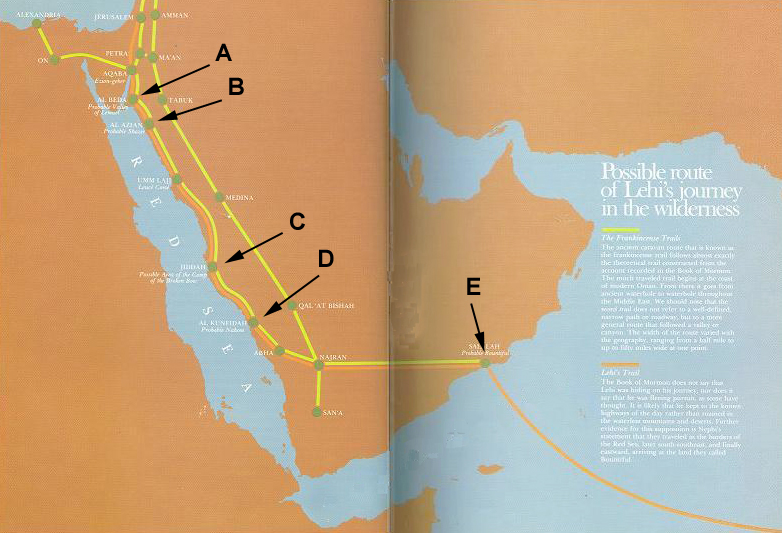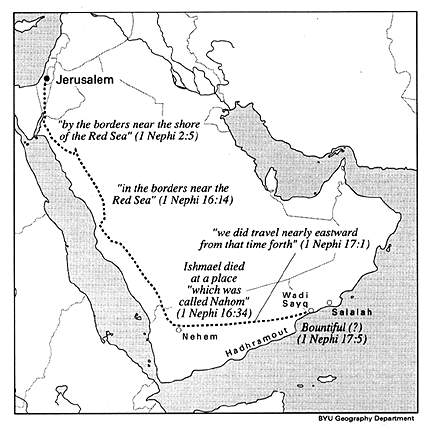
FAIR is a non-profit organization dedicated to providing well-documented answers to criticisms of the doctrine, practice, and history of The Church of Jesus Christ of Latter-day Saints.
A discussion of the Arabian, or Old World, geography of the Book of Mormon enjoys many advantages over discussion of New World matters. Chief among these is the fact that we know we certainty where the story begins—in Old World Jerusalem.
The details of Lehi's desert travels had been extracted from the text by the 1970s.[1] It is important to note how early these models were developed; current-day critics sometimes charge that LDS scholars have "retrofitted" their models to accommodate chance discoveries like "Nahom," but this is false.[2]
By describing in such precise detail a fertile Arabian coastal location, as well as the route to get there from Jerusalem (complete with directions and even a place-name en route), Joseph Smith put his prophetic credibility very much on the line. Could this young, untraveled farmer in rural New York somehow have known about a fertile site on the coast of Arabia? Could a map or some writing other than the Nephite record have been a source for him? The answer is a clear no. Long after the 1830 publication of the Book of Mormon, maps of Arabia continued to show the eastern coastline and interior as unknown, unexplored territory. In fact, until the advent of satellite mapping in recent decades, even quite modern maps have misplaced toponyms and ignored or distorted major features of the terrain.[3]
There is simply no way that Joseph could have obtained enough information about Arabia to fabricate more than a minute fraction of the travels described in First Nephi.
Models developed by LDS researchers predicted geographic locations long before they were located. Therefore, geographical correlates discovered later are confirmed predictions made by the geographical model offered by the Book of Mormon.

In the scan pictured here, hypothesized sites for Lehi's journey include:
The Hilton's acknowledged their debt to the writings of Hugh Nibley, which pushes the essentials of their model back to 1950.[4]
The Hilton's model—like all such models constructed from a text that gives only approximate distances at many points—has been tweaked slightly, but the basic layout of the journey has been remarkably stable. Most importantly, the subsequent findings which support the authenticity of the Book of Mormon's account fit neatly into Nibley's schema and the Hilton's model.
In 1986, Eugene England summarized 23 details of Arabian geography predicted by the Book of Mormon, and concluded that Joseph Smith would have not had access to the necessary information to forge so many inter-related facts. England's list read:

Some have noted that Alma 7:10 says that Jesus would be born "at Jerusalem which is the land of our forefathers." Yet, every schoolchild knows that Jesus was born in Bethlehem. They claim that this is a mistake, and evidence that Joseph Smith forged the Book of Mormon.
The town of Bethlehem is in the "land of Jerusalem." In fact, Bethlehem is only 5 miles south of Jerusalem: definitely "in the land," especially from the perspective of Alma, a continent away. Even locals considered Hebron, twenty five miles from Bethlehem, to be in the "land of Jerusalem." This is, in reality, another literary evidence for the Book of Mormon. While a forger would likely overlook this detail and include Bethlehem as the commonly-understood birthplace of Jesus, the ancient authors of the Book of Mormon use an authentic term to describe the Savior's birthplace—thereby providing another point of authenticity for the Book of Mormon.

This is an old criticism that has been dealt with at least as far back as 1842.[6] but continues to pop up now and again.
BYU professor Daniel C. Peterson pointed out the absurdity of this argument:
To suggest that Joseph Smith knew the precise location of Jesus' baptism by John ("in Bethabara, beyond Jordan" (1 Ne. 10:9) but hadn't a clue about the famous town of Christ's birth is so improbable as to be ludicrous. Do the skeptics seriously mean to suggest that the Book of Mormon's Bible-drenched author (or authors) missed one of the most obvious facts about the most popular story in the Bible — something known to every child and Christmas caroler? Do they intend to say that a clever fraud who could write a book displaying so wide an array of subtly authentic Near Eastern and biblical cultural and literary traits as the Book of Mormon does was nonetheless so stupid as to claim, before a Bible-reading public, that Jesus was born in the city of Jerusalem? As one anti-Mormon author has pointed out, "Every schoolboy and schoolgirl knows Christ was born in Bethlehem." [Langfield, 53.] Exactly! It is virtually certain, therefore, that Alma 7:10 was foreign to Joseph Smith's preconceptions. "The land of Jerusalem" is not the sort of thing the Prophet would likely have invented, precisely for the same reason it bothers uninformed critics of the Book of Mormon.[7]
It is important to note what Alma's words were. He did not claim Jesus would be born in the city of Jerusalem, but "at Jerusalem which is the land of our forefathers."
Thus, the Book of Mormon makes a distinction here between a city and the land associated with a city. It does this elsewhere as well:
This is consistent with the usage of the ancient Middle East. El Amarna letter #290 reports that "a town of the land of Jerusalem, Bit-Lahmi [Bethlehem] by name, a town belonging to the king, has gone over to the side of the people of Keilah."[8] (One over-confident 19th century critic blithely assured his readers that "There is no such land. No part of Palestine bears the name of Jerusalem, except the city itself."[9] While this was perhaps true in the 19th century, it was not true anciently. A supposed "howler" turns into evidence for the text's antiquity.
Thus, the Book of Mormon gets it exactly right — the town of Bethlehem is in the "land of Jerusalem." In fact, Bethlehem is only 5 miles south of Jerusalem: definitely "in the land," especially from the perspective of Alma, a continent away. Even locals considered Hebron, twenty five miles from Bethlehem, to be in the "land of Jerusalem."
Hugh Nibley noted in 1957:
while the Book of Mormon refers to the city of Jerusalem plainly and unmistakably over sixty times, it refers over forty times to another and entirely different geographical entity which is always designated as "the land of Jerusalem." In the New World also every major Book of Mormon city is surrounded by a land of the same name.
The land of Jerusalem is not the city of Jerusalem. Lehi "dwelt at Jerusalem in all his days" (1 Nephi 1꞉4), yet his sons had to "go down to the land of our father's inheritance" to pick up their property (1 Nephi 3꞉16,22). The apparent anomaly is readily explained by the Amarna Letters, in which we read that "a city of the land of Jerusalem, Bet-Ninib, has been captured."17 It was the rule in Palestine and Syria from ancient times, as the same letters show, for a large area around a city and all the inhabitants of that area to bear the name of the city.18 It is taken for granted that if Nephi lived at Jerusalem he would know about the surrounding country: "I, of myself, have dwelt at Jerusalem, wherefore I know concerning the regions round about" (2 Nephi 25꞉6; italics added). But this was quite unknown at the time the Book of Mormon was written—the Amarna Letters were discovered in 1887. One of the favorite points of attack on the Book of Mormon has been the statement in Alma 7꞉10 that the Savior would be born "at Jerusalem which is the land of our forefathers" (italics added). Here Jerusalem is not the city "in the land of our forefathers"; it is the land. Christ was born in a village some six miles from the city of Jerusalem; it was not in the city, but it was in what we now know the ancients themselves designated as "the land of Jerusalem." Such a neat test of authenticity is not often found in ancient documents.[10]

FAIR is a non-profit organization dedicated to providing well-documented answers to criticisms of the doctrine, practice, and history of The Church of Jesus Christ of Latter-day Saints.
We are a volunteer organization. We invite you to give back.
Donate Now